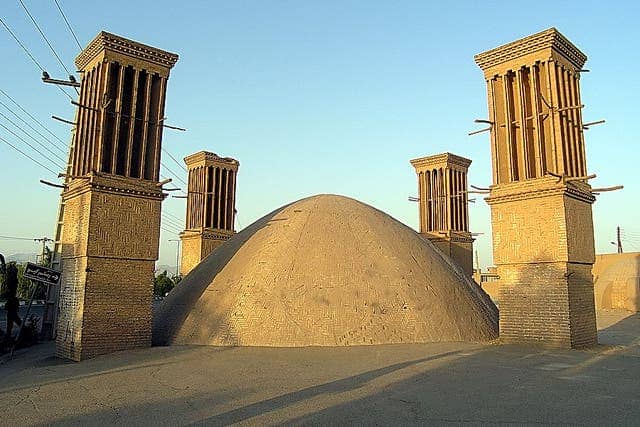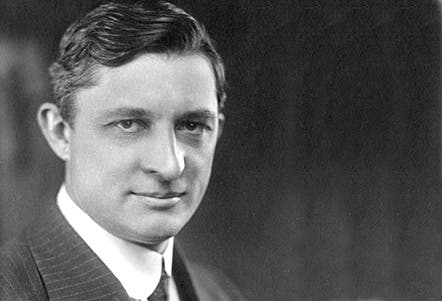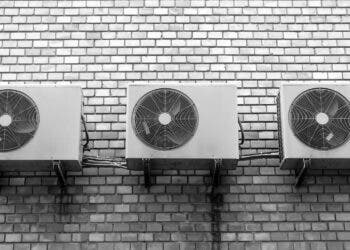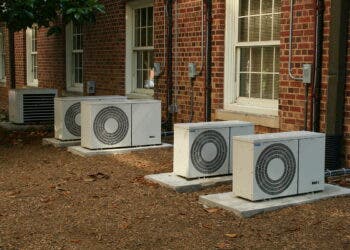
People have been trying to outsmart heat waves for thousands of years but it wasn’t until 1902 that modern air conditioning was invented. You have an American engineered called Willis Carrier to thank for this invention that forever changed the world.
Ancient attempts at air conditioning
One of the first people to try to cool their homes were unsurprisingly the Egyptians, who had to deal with scorching temperatures most of the year. The ancient Egyptians would hang wet mats over the doorways. Once the water starts to evaporate, heat gets sucked out. This primitive, but ingenious method had the added benefit of raising the moisture in the air, which was very desirable in dry climates.
Later on, in the Roman Empire, more advanced air conditioning was introduced. Using their famous aqueducts, some wealthy Romans circulated cold, fresh water from upstream through pipes fitted inside their villas. During the ‘dies canicula’, a Roman term for the hot period of weather between July and mid-August, Romans who couldn’t afford cooled pipes would congregate at the public baths. Here, they would find the frigidarium, a large cold pool.

The White Horse Temple in China, built during the Han Dynasty (202 BC–220 AD), had a Cool Hall. Inside, rotary fans powered party by water, party by human hands, chilled the elite during the hot summer days.
In the Middle East, Persians built wind towers known as ‘wind catchers’ which were fitted with windows through which the prevailing winds would sweep. With the help of interior vanes, the cooler air was introduced into homes, and the warm air was sucked out.
Experimental refrigeration
In 1778, renowned inventor and statesmen Benjamin Franklin, along with his friend John Hadley, a professor at Cambridge University, started to experiment with the refrigerating effects of certain substances. Their studies suggest that the faster a liquid evaporates, the colder the surrounding air would get. Using ether, the two showed it was possible to cool a mercury thermometer below the freezing point. Franklin would later remark in his journal that ‘it’s possible to freeze to death even on a warm summer’s day.’
Later, in 1820, Michael Faraday learned that by compressing ammonia, the gas becomes a liquid. As it evaporated, the ammonia cooled the air inside his lab.
The first thing that resembled an air conditioner was patented in 1851 by a Florida physician named John Gorrie. His device compressed air and water to create an open cooling system meant to keep yellow fever patients cool. It was aptly called the ‘cold air machine’.
The inventor of modern air conditioning
The modern air conditioner didn’t surface, however, until the early 20th century. Luckily, Willis Carrier came into the picture and the world would never be the same. His invention, however, was intended for a far less grand purpose.
Carrier had been born in 1876 to an old New England family, which as an interesting trivia tidbit included an ancestor who was hung as a witch in Salem. After finishing his studies at Cornell University, Carrier became employed at a company that owned a printing press.
He proved himself with various technical upgrades that saved the company a lot of money and was promoted to the head of a new department of experimental engineering. One of his first tasks was to design a system that would reduce moisture in the printing room so pages wouldn’t get wrinkled.
Carrier realized he could dry air by passing it through the water to create fog. Within a year, he create a machine fitted with chilled coils that could control humidity, maintaining it at a constant 55 percent inside the Sackett-Wilhelms printing house. That’s the equivalent of using 108,000 pounds of ice daily to cool the plant.
The term ‘air conditioner’, however, was coined by Stuart Crame who invented a similar device.
While working at Sackett-Wilhelms, Carrier partnered with one Irvine Lyle, at the time a salesman at the printing house, and started Carrier Corp., a company that sold air conditioners to Americans and would become very successful in the 1950s.
It took a while before normal, working-class Americans could afford this invention. The first home air conditioner was installed in 1914 in the mansion of millionaire Charles Gates who hired Carrier for the job. This machine was the size of a whole room, bulky, and extremely noisy.
Though adoption was slow, the 1950s and 1960s came with a boom in sales. Nowadays, 90 percent of American homes use air conditioning, making summer days more manageable at home and more productive at work.
How does an AC work?

An air conditioning system’s job is to pull in heat from your room and dump it outside your house. However, as simple as that may sound, there’s a clever bit of physics and engineering involved. So before you dive into the mechanical function of an air conditioner (AC), you must understand a few basic concepts of thermodynamics.
- The first law of thermodynamics states that heat can only be transferred from one location to another. One can’t just create or dissipate heat out of nowhere. An AC utilizes this principle daily by taking the heat from our rooms and venting it outside of our homes.
- According to the second law of thermodynamics, heat transfer only occurs from a higher to a lower temperature location, meaning when you have two locations or objects at different temperatures. The hotter location or object cools down, and the colder location or object warms up.
Now that you have a fair idea of how heat transfer happens, let’s look at how the four major components of an AC work and provide you with much-needed cooling on a hot summer day.
Evaporator
The evaporator turns the liquid refrigerant (such as R-22 or R-410A) into a gaseous vapor by absorbing heat from your room and moving it to the refrigerant inside its coil. Due to heat absorption, the liquid refrigerant turns into a vapor that is then sent to the condenser. The evaporator’s temperature is always colder than your room in order to allow heat transfer to the evaporator coil.
Condenser
The condenser is located in an air conditioner’s outdoor unit (ODU). It has a network of metallic fins through which the condenser transfers heat from the vaporized refrigerant to the surrounding environment. Condensers are also known as heat exchangers because of their role in expelling heat out of the system. When the hot refrigerant vapor passes through a condenser, a drop in temperature forces it back into a liquid stage, ready to be fed back into the compressor.
Expansion valve
Boiling occurs when a liquid gains heat and changes to the vapor state, whereas superheating happens when a vapor is heated above the boiling point of the liquid. Superheating is an essential part of the cooling process. It ensures that before leaving the evaporator and reaching the compressor, the liquid refrigerant of the air conditioner is completely vaporized. The vaporization of refrigerant is essential because the compressor can undergo severe damage if it comes in contact with liquid refrigerant.
The thermal expansion valve between the evaporator and condenser controls the flow and amount of refrigerant that moves towards the evaporator and ensures a steady flow required to achieve superheating.
Compressor
The compressor is the heart of an air conditioning unit. The gaseous refrigerant is reduced in volume by compression and sent to the system in a liquid state. Next, the compressor receives a cooled-down refrigerant from the vaporizer and converts it into liquid form. Finally, it is ready to be fed to the vaporizer to continue the cooling cycle.
Applications of air-conditioning systems
From increasing our quality of life to keeping our surroundings comfortable even in extreme climatic regions and preserving food and medical supplies while they are transported from one corner of the world to the other, air conditioning has played a major role. Here are some other important applications of air conditioning systems:
- Air conditioners can be considered the silent heroes of the medical community. They operate behind the scenes to provide cooling and dehumidify medical facilities and hospitals while also reducing the spread of some airborne infections. Complex medical surgeries (such as heart surgery) demand temperature management which is achieved via air conditioning or HVAC units.
Moreover, pharma and medical units also require strict “air-conditioned and clean” environments for their research and development labs, manufacturing units, and storage facilities. However, AC can facilitate the transmission of other pathogens — sometimes, it’s best just to leave your windows open. - Industrial air conditioning is essential for the optimum functioning of power plants, metal mines, metal-based production facilities, textile and paper mills, ice-cream plants, microprocessor manufacturing units, and various other industries.
For instance, most modern power plants have a compact control room that stores the microprocessors responsible for regulating power plant operations. These microprocessors require low temperatures to function, which is achieved through advanced air conditioning systems. - Air conditioning systems are also employed in data centers and server rooms where a large number of computer or network servers are stored. The air conditioning systems prevent the servers and data storage units from overheating. Moreover, aerospace companies use air conditioning systems to produce aircraft components and keep the environment inside a rocket or a plane dust-free.
Apart from these heavy applications, there are many more simple uses of AC units; for example, many animal farm owners use air-conditioning systems to keep their livestock comfortable during the summer so that the milk yield is not affected. So now you know air-conditioning is much more than just a means to feel relaxed, it helps factories function well and businesses grow fast.
Not everything is cool about AC
Not everything is positive about ACs. In fact, they are highly responsible for increasing our carbon footprint and releasing harmful chemicals into our environment. Until recently, air conditioners used CFCs or chlorofluorocarbons as refrigerants (now, hydrofluorocarbon or HFC is used which is believed to be less dangerous to the environment). Upon release into the atmosphere, the CFCs damage the ozone layer, and form what is known as the ‘ozone hole.’

Since the beginning of CFCs production in the 1920s, the thickness of the ozone layer, on average, has reduced by three percent, and this has immensely contributed to the climate change threats that we are facing at present. Another big issue arising from widespread air conditioning use is the huge energy consumption.
On average, a typical air conditioning unit consumes about 3000 to 5000 watts of electricity every hour, leading to increasing global electricity demand. Since most of the electric power in many countries still comes from burning fossil fuels, the increased demand is causing environmental pollution and more carbon emissions.
The biggest environmental concern with modern air conditioning, however, is energy use — energy which nowadays is still largely derived from fossil fuels. Almost 20 percent of electricity consumption in U.S. homes goes to AC or nearly as much as the whole continent of Africa uses for all purposes.
Moreover, ACs can also lead to skin diseases and various health-related problems (such as arthritis, eye infection, respiratory ailments, etc.). A study was conducted on two groups, one working in air-conditioned cabins and the other in a naturally ventilated office, revealed that people who spent their working hours in the AC-free office faced fewer health-related issues than the ones who worked in an AC-equipped office
According to researcher William Fisk “A large body of research has found that occupants of offices with air conditioning tend to report more sick building syndrome (SBS) symptoms than occupants of naturally ventilated offices.”
The cost of the comfort that ACs provide is very high, and by cost, here you should not only consider your electricity bill but the environmental problems that are caused due to the use of ACs. In the times, when humanity is focused on creating more earth-friendly and sustainable solutions, we definitely need better cooling solutions, so the next time you see an air conditioner turned on, even when there’s no need, switch it off!







